 The company’s financials show steady revenue growth and improved net income margin. Management has implemented financing programs for liquidity, focusing on market disruptions and risk mitigation. Key performance indicators include supply chain disruptions and successful product introductions. The company’s ROI exceeds its cost of capital, and market share remains stable. Risk assessment includes legal issues, cybersecurity risks, and operational challenges. Corporate governance emphasizes sustainability initiatives, but board diversity is not explicitly mentioned. Forward guidance involves strategic initiatives to address climate change and industry demands, emphasizing sustainability and innovation for long-term growth.
The company’s financials show steady revenue growth and improved net income margin. Management has implemented financing programs for liquidity, focusing on market disruptions and risk mitigation. Key performance indicators include supply chain disruptions and successful product introductions. The company’s ROI exceeds its cost of capital, and market share remains stable. Risk assessment includes legal issues, cybersecurity risks, and operational challenges. Corporate governance emphasizes sustainability initiatives, but board diversity is not explicitly mentioned. Forward guidance involves strategic initiatives to address climate change and industry demands, emphasizing sustainability and innovation for long-term growth.
Executive Summary
Financials
Revenue growth has been steady over the past three years, with a slight decrease in the effective tax rate driving the trend. This decrease was mainly due to higher discrete equity compensation tax deductions for the three months ending March 31, 2024. Operating expenses decreased by $16 million from Q1 2023 to Q1 2024. The decrease was mainly driven by a reduction in selling, general, and administrative expenses. Engineering expenses also decreased, but to a lesser extent. The company’s net income margin is $277. It has improved compared to the previous period. It is higher than industry peers.
Management Discussion and Analysis
Management has implemented a supply chain financing program and short-term financing agreements with banks to enhance liquidity. The success of these initiatives in driving growth and profitability is not explicitly stated in the information provided. Management assesses the company’s competitive position through actions of competitors and negotiations with partners. They highlight market disruptions like supply disruptions, technical difficulties, and increases in raw material costs. Management identified major risks including climate change impacts, natural hazards, health crises, economic downturns, facility shutdowns, and supply chain disruptions. Mitigation strategies include staying updated on climate policies, implementing disaster preparedness plans, monitoring health crises, diversifying sourcing, and maintaining financial stability.
Key Performance Indicators (KPIs)
Risk Assessment
Legal proceedings, acquisitions, new technology, cybersecurity risks, competitor actions, negotiations outcome, political/governmental factors, supply disruptions, technical difficulties, operating conditions/costs changes, raw material cost increases, new product introduction success, long-term contract performance, labor availability/relations. WAB assesses and manages cybersecurity risks by staying vigilant, adapting to new technologies, and implementing robust security measures across all digital platforms. Regular monitoring and addressing potential threats are key priorities in the ever-evolving digital business environment. Yes, there are contingent liabilities and legal issues that could impact the company’s financial position and reputation. WAB is addressing them by complying with environmental laws, seeking insurance coverage for asbestos-related claims, and defending against antitrust allegations in court.
Corporate Governance and Sustainability
The composition of the board of directors is not mentioned in the provided context information. No notable changes in leadership or independence were discussed. The company’s governance practices mention legal proceedings, acquisitions, and technology, but there is no explicit mention of diversity and inclusion or board diversity commitments in the provided context. The report mentions sustainability initiatives such as Green Finance Framework and ESG topics prioritized by external stakeholders. WAB shows commitment to responsible business practices by addressing climate change impacts and health crises in its risk assessments.
Forward Guidance
The company’s forward-looking guidance addresses strategic initiatives like climate change policy and natural hazard impacts outlined in the annual report, ensuring preparedness for disruptions and risks. WAB is factoring in supply disruptions, technical difficulties, operating conditions and costs, raw material costs, new product introductions, and labor availability into its forward-looking guidance. It plans to capitalize on these trends through its liquidity management strategy and short-term financing agreements. Yes, the company’s focus on evolving climate change policy and industry demand for faster and more efficient braking equipment indicate investments in sustainability and innovation for long-term growth and competitiveness.
For more information:
This article was created using artificial intelligence technology from Klickanalytics.





